Elevate your daily ritual with a perfect **homemade matcha latte**! Forget expensive café visits; you can craft a warm, comforting, and café-quality drink right in your own kitchen in mere minutes. This comprehensive guide will walk you through every step, from selecting the finest matcha powder to achieving that ideal frothy texture. Whether you crave a soothing hot beverage or a refreshing **iced matcha latte**, we’ve got you covered with simple instructions and expert tips.

Why You’ll Adore Your Homemade Matcha Latte
There’s an undeniable allure to a well-made matcha latte. The harmonious blend of earthy green tea, creamy milk, and a touch of sweetness creates a uniquely satisfying flavor profile that’s both invigorating and calming. While store-bought mixes and many café versions often disappoint with excessive sweetness or a gritty texture, crafting your own **homemade matcha latte** empowers you to control every aspect, ensuring a truly sublime experience tailored to your taste buds.
Beyond the delightful taste, there are numerous reasons to embrace the art of homemade matcha:
- Effortlessly Easy: Contrary to popular belief, preparing **matcha powder** is far from complicated. With just a few simple steps and minimal equipment, you can enjoy a beautifully frothed hot latte or a cool, refreshing iced version in under five minutes. It’s a surprisingly quick and rewarding process perfect for busy mornings or an afternoon pick-me-up.
- Infinitely Versatile: The beauty of a **homemade matcha latte** lies in its adaptability. You have complete freedom to experiment with various types of milk, sweeteners, and even additional flavorings to perfectly match your preferences. Whether you prefer a dairy-free option, a specific sweetener, or a unique twist, the possibilities are endless.
- Naturally Energizing & Focused: Matcha is renowned as a natural stimulant, offering a sustained energy boost without the typical jitters or a subsequent caffeine crash often associated with coffee. This is due to L-theanine, an amino acid unique to green tea, which promotes a state of calm alertness and enhanced focus. It’s an ideal beverage to kickstart your day or provide a gentle lift during a midday slump.
- Rich in Antioxidants: Beyond its energizing properties, matcha is a powerhouse of antioxidants, particularly catechins like EGCG (epigallocatechin gallate). These compounds are celebrated for their potential health benefits, including supporting metabolism, boosting immunity, and contributing to overall well-being.
Prepared with quality almond milk and a hint of raw honey, my signature **matcha latte recipe** delivers a wonderfully foamy texture, a subtle sweetness, and an unparalleled depth of flavor. For the ultimate morning treat, consider pairing it with a delicious cherry chocolate muffin or a bright lemon poppy seed muffin.
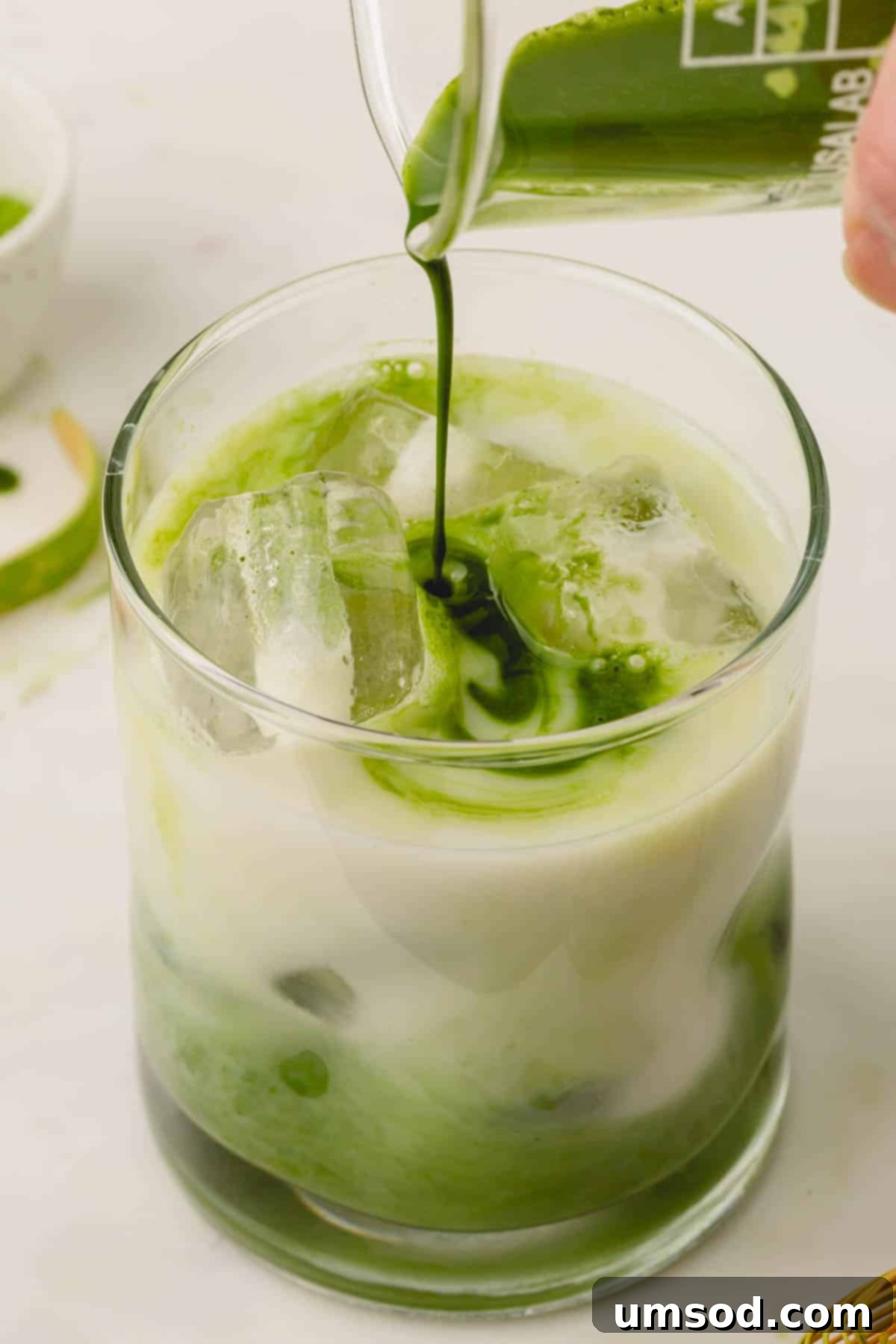
Understanding Matcha: The Heart of Your Latte
**Matcha** is much more than just green tea; it’s a finely ground powder made from specially cultivated and processed green tea leaves. Originating in Japan, matcha holds a significant place in Japanese tea ceremonies and is celebrated globally for its unique flavor and remarkable health benefits.
Unlike regular green tea, where leaves are steeped and then discarded, with matcha, you consume the entire tea leaf. This means you ingest a higher concentration of beneficial compounds, including chlorophyll, antioxidants, and L-theanine. The cultivation process for matcha is also unique: tea plants are shaded for several weeks before harvest, which boosts chlorophyll production and increases amino acid content, resulting in a sweeter, less bitter flavor and a vibrant green color.
After harvesting, the leaves are destemmed and deveined to become “tencha,” which is then stone-ground into the delicate **matcha powder** we use. There are typically two main grades of matcha:
- Ceremonial Grade Matcha: This is the highest quality matcha, characterized by its vibrant green color, smooth texture, and naturally sweet, umami flavor with minimal bitterness. It’s ideal for drinking on its own or for making lattes where the matcha flavor is the star.
- Culinary Grade Matcha: While still beneficial, culinary grade matcha has a bolder, more astringent flavor and is often used in baking, cooking, or for stronger flavored lattes where other ingredients might mask its taste. For a truly exceptional **homemade matcha latte**, always opt for ceremonial grade.
To dive deeper into the world of matcha, including its fascinating history, various types, and brewing techniques for plain matcha tea, explore our comprehensive Matcha 101 guide.
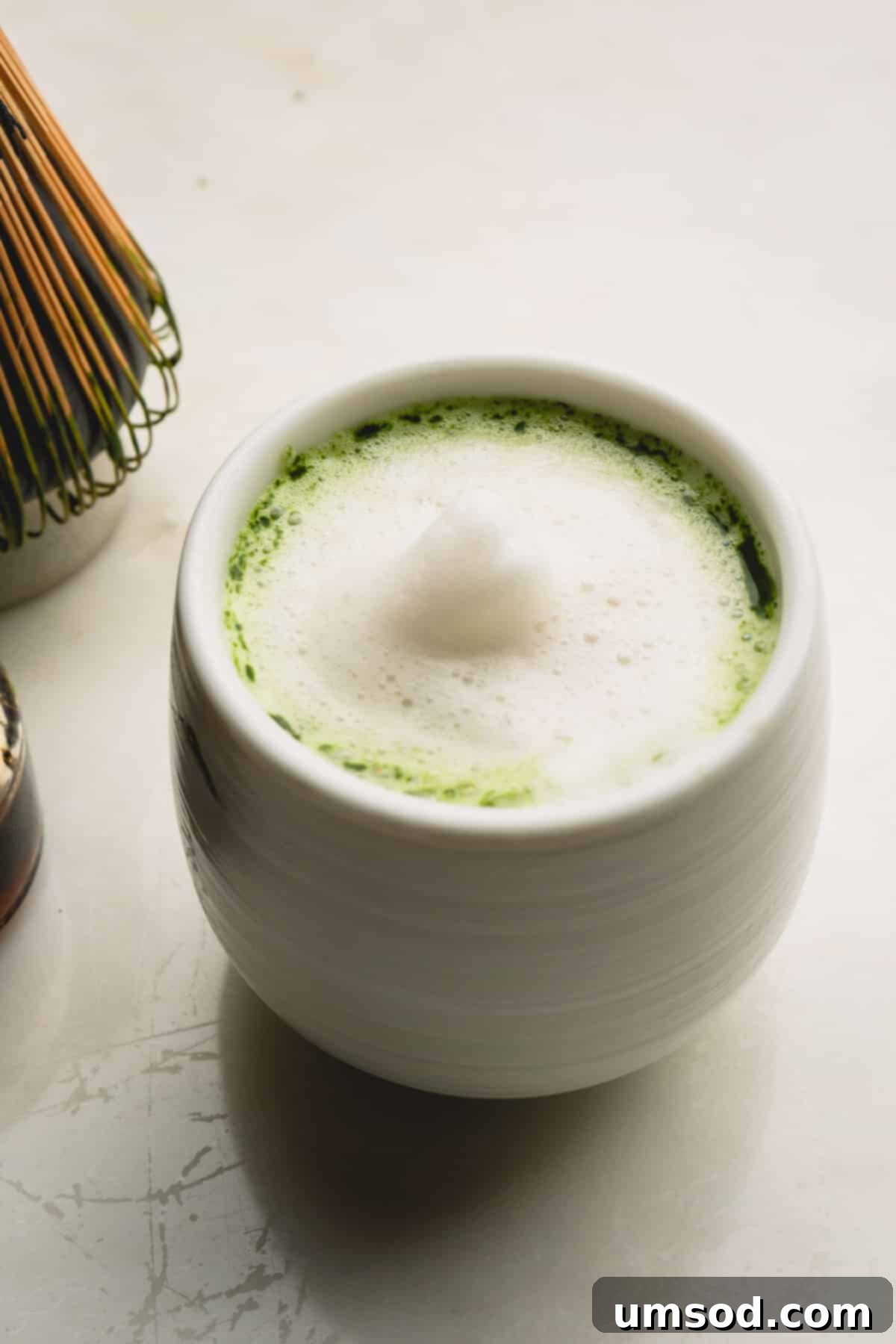
Key Ingredients for Your Perfect Matcha Latte
Crafting an exquisite **homemade matcha latte** relies on a few high-quality ingredients. Here’s what you’ll need and some tips for making the best choices:
- Sweetener: I personally find that raw honey beautifully complements the earthy notes of matcha, adding a nuanced sweetness. Maple syrup is another fantastic option, offering a rich, caramelized flavor. You can also use agave nectar, stevia, or simply omit sweetener if you prefer the pure taste of matcha and milk. Adjust the amount to your desired sweetness level.
- Matcha Powder: This is arguably the most critical ingredient. For a silky-smooth texture and a vibrant, less bitter taste, always opt for **ceremonial-grade matcha powder**. While culinary-grade matcha is suitable for baking, it can result in a more astringent latte. Investing in a high-quality ceremonial-grade matcha will significantly enhance your drinking experience.
- Hot Water: The temperature of your water is paramount. Use hot water, but crucially, *not boiling water*. Water that is too hot (above 175°F or 80°C) will scorch the delicate matcha powder, leading to an unpleasantly bitter taste. Aim for water between 160°F and 175°F (70°C to 80°C) for optimal flavor extraction.
- Milk: The beauty of a latte is its creamy base. You have a wide array of choices here, and all can work wonderfully!
- Dairy Milk: Whole milk or 2% milk will create a rich, creamy, and naturally sweet latte with excellent frothing capabilities.
- Almond Milk: My personal favorite, almond milk provides a delicate, slightly nutty flavor that pairs exceptionally well with matcha and froths beautifully for a dairy-free option.
- Oat Milk: Known for its creamy texture and mild, slightly sweet taste, oat milk is another popular choice that creates a wonderfully smooth and frothy latte.
- Coconut Milk: For a tropical twist and extra richness, full-fat canned coconut milk (the creamy part) or carton coconut milk works great.
- Soy Milk: A classic plant-based option, soy milk offers a creamy texture and good frothing.
Feel free to experiment to find your preferred milk base!
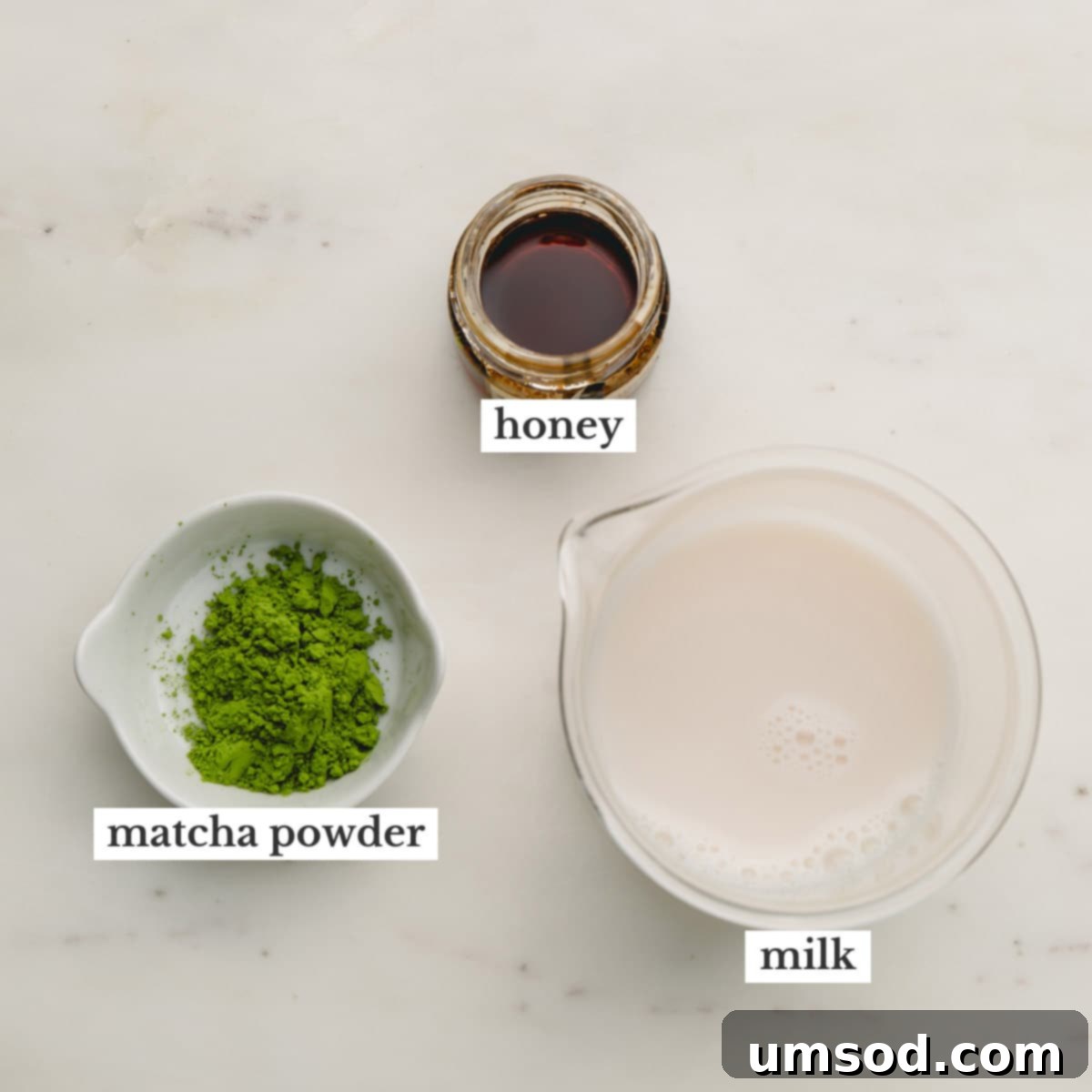
How to Craft Your Perfect Hot Matcha Latte
Making a **homemade matcha latte** is a wonderfully simple process that can easily become a cherished part of your morning routine. My husband and I enjoy this daily, so I’ve refined the steps to be as efficient and delicious as possible:
- Prepare Your Matcha Paste: Begin by scooping 1 to 2 teaspoons of **ceremonial-grade matcha powder** into a small bowl or a wide-mouthed mug. The amount of matcha can be adjusted based on your desired strength and preferred flavor intensity.
- Add a Touch of Hot Water: Carefully add just a tablespoon of hot water to the matcha powder. Remember, the water should be hot but not boiling (ideally between 160°F and 175°F or 70°C to 80°C) to prevent burning the delicate tea leaves.
- Whisk to a Smooth Paste: This is a crucial step for a lump-free latte. Use a bamboo whisk (chasen) if you have one, employing a rapid ‘M’ or ‘W’ motion to incorporate the water thoroughly. Alternatively, a small, flexible silicone spoon or even a small metal whisk works effectively to break down any clumps and create a smooth, vibrant green paste. Continue whisking until the mixture is entirely free of lumps and has a consistency similar to thin paint.
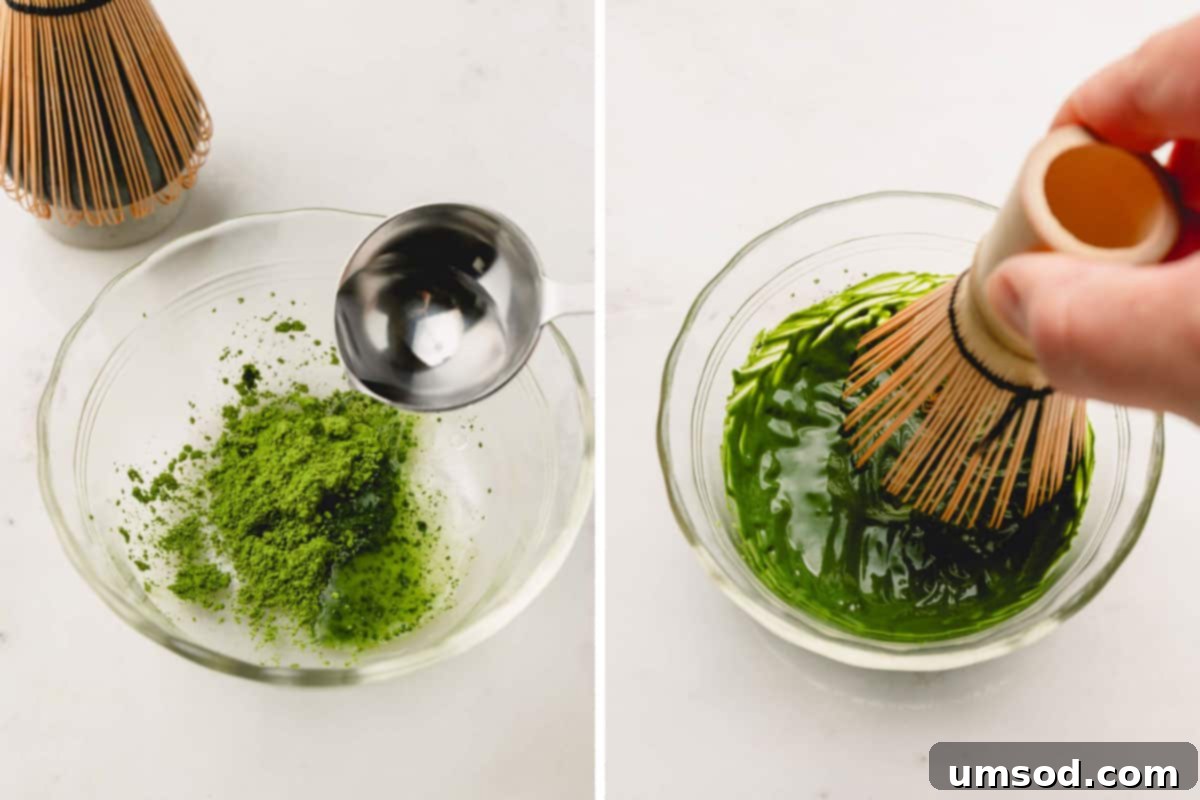
Pro Tip: Achieving a Lump-Free Matcha Paste
The secret to a silky smooth **matcha latte** lies in the initial paste. Using minimal water (just a tablespoon) makes it much easier to thoroughly combine the powder and water into a smooth, concentrated paste. Think of it like making a roux; you want a thick consistency first. Matcha powder doesn’t truly dissolve in water; rather, the fine particles are suspended. Creating a paste ensures even dispersion before adding more liquid.
While some recipes recommend sifting the matcha powder, I generally skip this step to avoid extra dirty dishes. With a good whisking technique and the right amount of water, sifting isn’t usually necessary for a lump-free result.
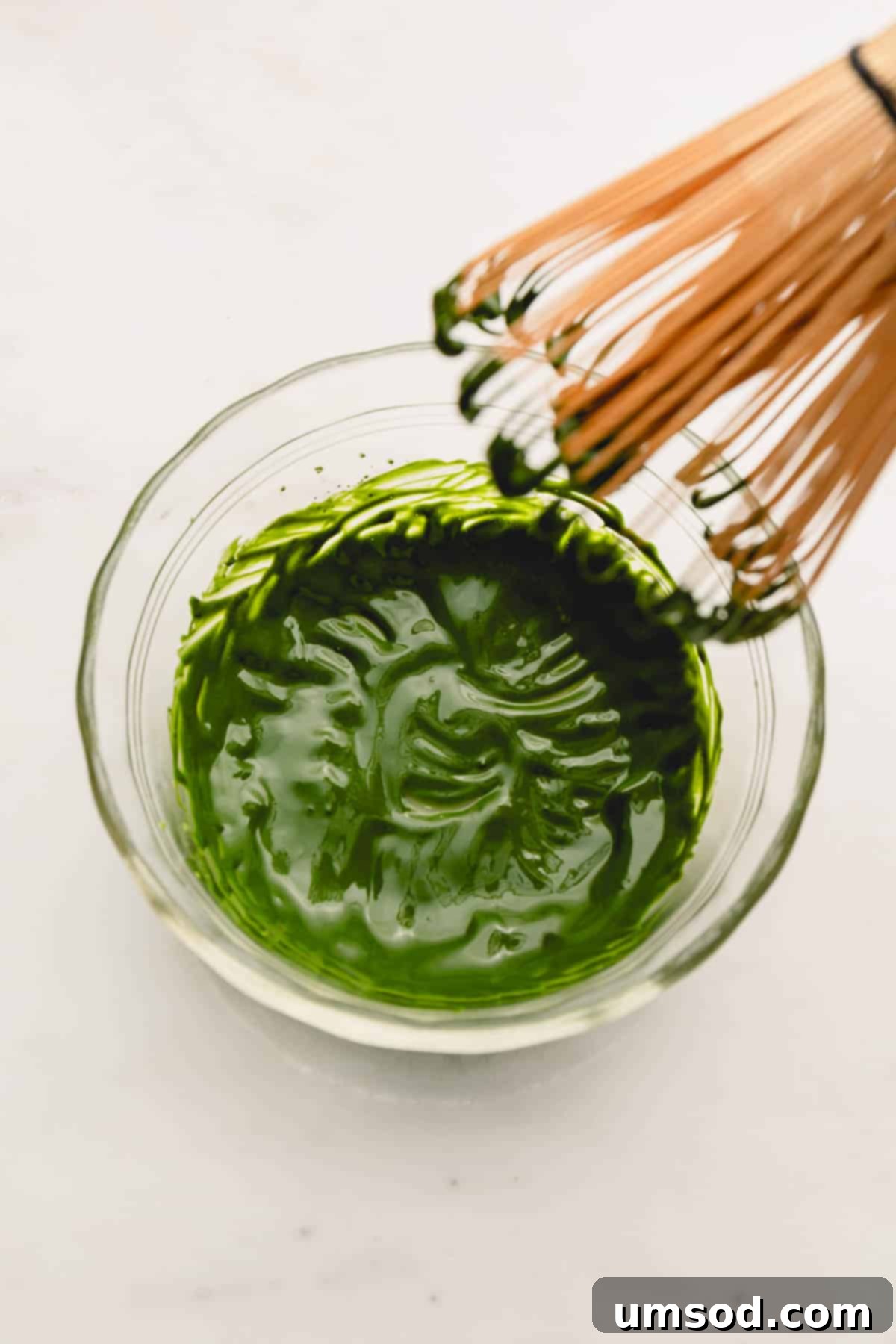
- Prepare and Froth Your Milk: Gently warm your chosen milk (e.g., almond milk) on the stovetop or in the microwave until hot but not boiling. If desired, stir in your sweetener of choice, such as honey or maple syrup, while warming. Once warm, use a handheld milk frother, an espresso machine’s steam wand, or even a French press to create a lovely, airy foam. Aim for a luscious, creamy texture.
- Combine and Enjoy: Pour the frothed milk directly over the prepared matcha paste in your cup. The rich green of the matcha will beautifully swirl with the creamy white of the milk. For an added touch of elegance, gently spoon any remaining milk foam on top. Your perfect hot **homemade matcha latte** is now ready to be savored!

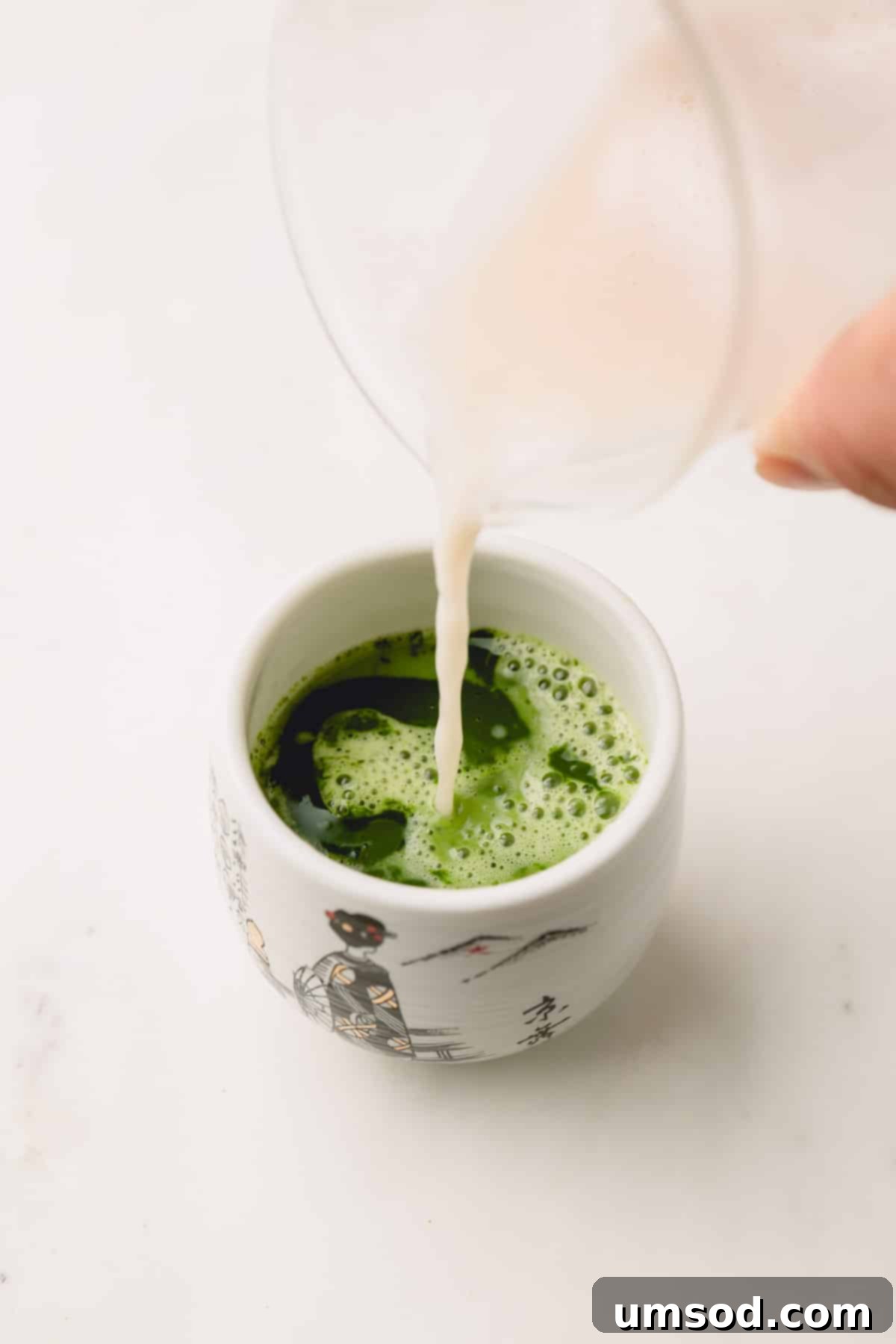
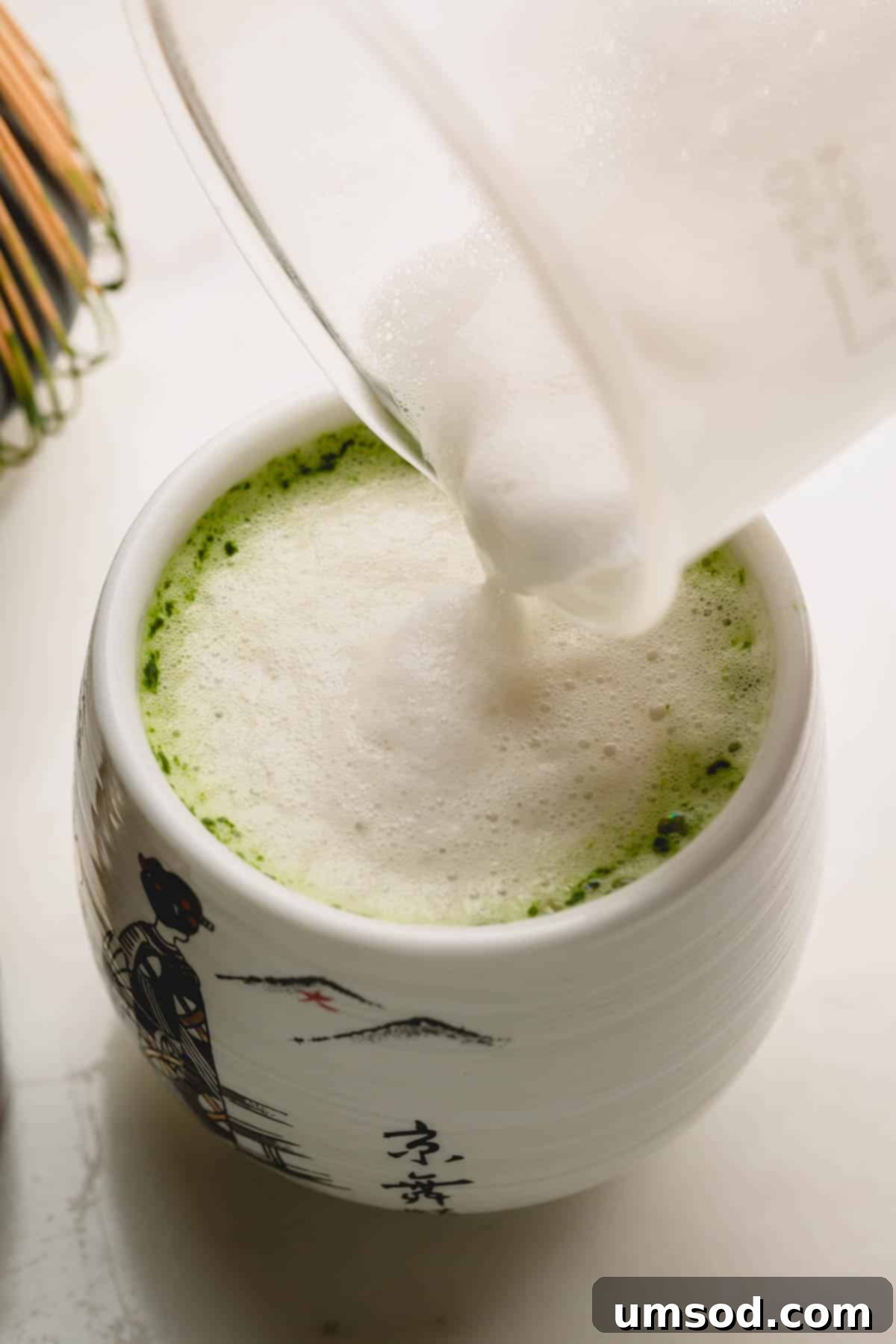
Crafting a Refreshing Iced Matcha Latte
When the weather warms or you simply crave a cool and invigorating drink, an **iced matcha latte** is the perfect choice. The preparation is quite similar to the hot version, with a few key adjustments for that refreshing chill:
- Prepare Your Matcha Paste: As with the hot latte, start by making a smooth matcha paste. Scoop 1-2 teaspoons of **matcha powder** into a small bowl and add just 1 tablespoon of hot water (160-175°F). Whisk thoroughly until all lumps are gone and you have a consistent, vibrant green paste.
- Thin Out the Paste: Once your paste is perfectly smooth, stir in an additional 1-2 tablespoons of cold water. This step is crucial for an **iced matcha latte**, as it helps thin out the concentrated paste, making it much easier to mix evenly with cold milk and prevent it from settling at the bottom of your glass.
- Assemble Your Iced Latte: Fill a tall glass generously with ice cubes. Pour in your desired amount of cold milk (almond, oat, or dairy work wonderfully) and add your sweetener if using (honey or maple syrup blend well). Finally, gently pour the thinned matcha paste over the milk and ice.
- Stir and Enjoy: Give your **iced matcha latte** a good stir with a spoon or straw until the green matcha is beautifully swirled throughout the milk. Take a moment to appreciate the refreshing aroma and vibrant color before taking your first sip. It’s an instant cool-down with all the energizing benefits of matcha!
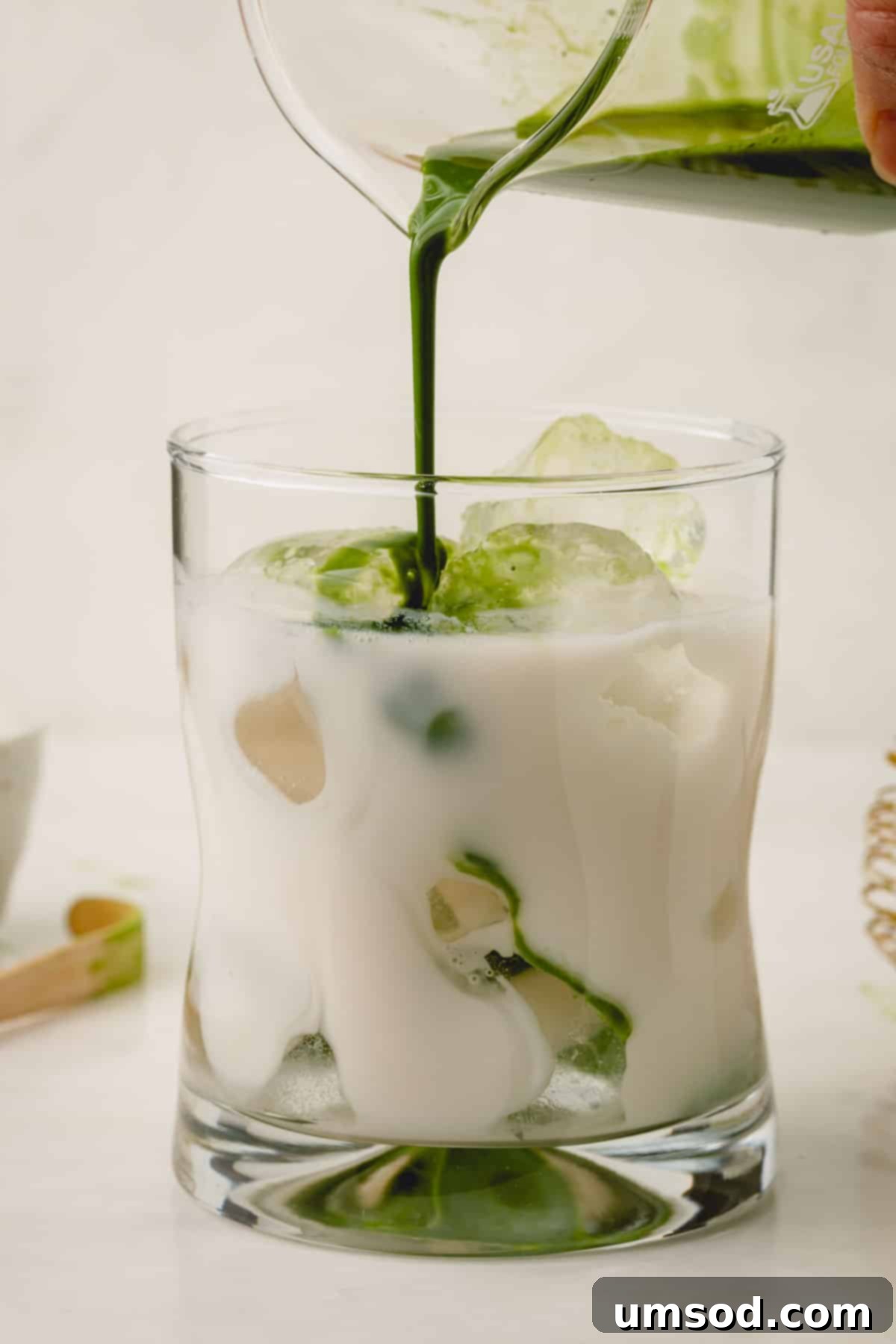
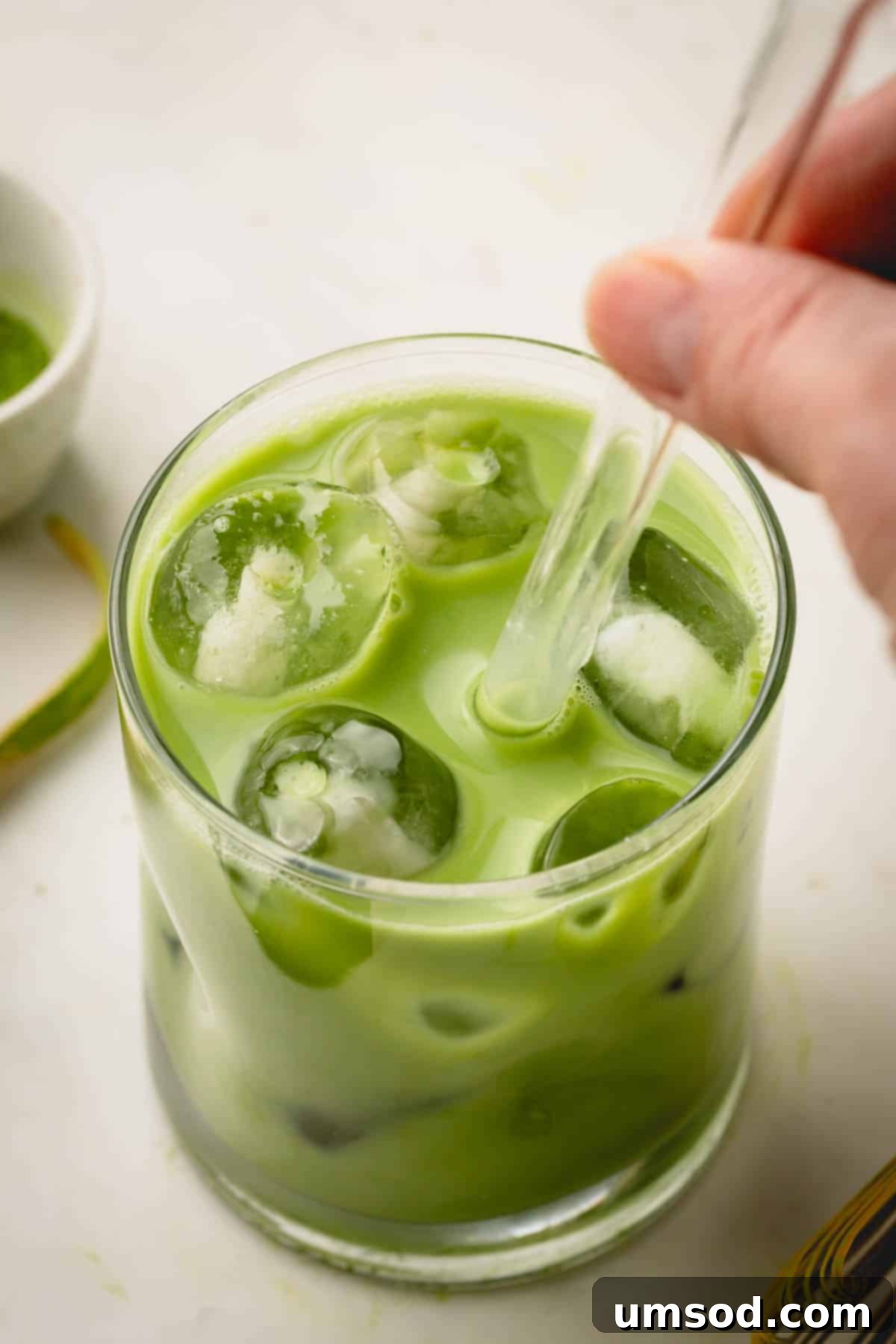
Iced Matcha Latte Secret for Smoothness
For the best **iced matcha latte**, remember to thin out your concentrated matcha paste with an extra 1–2 tablespoons of cold water after whisking it with the initial hot water. This small step ensures the matcha disperses effortlessly into the cold milk, preventing any clumping and guaranteeing a consistent, smooth taste from your first sip to your last.
Essential Tips for Your Best Homemade Matcha Latte
To consistently create an exceptional **homemade matcha latte**, keep these valuable tips in mind:
- Prioritize High-Quality Matcha: The quality of your **matcha powder** directly impacts the flavor of your latte. **Ceremonial-grade matcha** offers a naturally smoother, sweeter, and less bitter profile, along with a more vibrant green hue. While it might be a slightly higher investment, the difference in taste is well worth it. This brand of ceremonial matcha is a fantastic choice for consistent quality.
- Master Water Temperature: As previously mentioned, very hot or boiling water can “burn” the delicate matcha, resulting in an unpleasant, bitter flavor. Always allow boiled water to cool for a minute or two, aiming for a temperature between 160°F and 175°F (70°C to 80°C). This optimal temperature extracts the best flavors without compromising the matcha’s integrity.
- Adjust Ratios to Your Palate: Everyone’s taste is unique. If you’re new to matcha, start with the recommended ratios and then don’t hesitate to experiment!
- For a milder taste, add a little more water or milk.
- If you prefer a stronger, more intense matcha flavor, slightly increase the amount of **matcha powder**.
- Similarly, adjust your sweetener until it perfectly matches your preference.
Finding your ideal balance is part of the fun of making your own **matcha latte**.
- Serve Immediately for Peak Freshness: Matcha lattes are best enjoyed right after preparation. As they cool, the delicate flavors can diminish, and some of the fine matcha particles may settle at the bottom of your cup. Give it a quick stir if you let it sit for a moment!
- Proper Matcha Storage: To maintain the freshness, vibrant color, and potent flavor of your **matcha powder**, always store it in an airtight container in a cool, dark place, away from light, heat, and moisture. Refrigeration is ideal after opening to prolong its shelf life and prevent oxidation.
- Invest in Essential Tools: While not strictly necessary, a bamboo whisk (chasen) and a handheld milk frother can significantly elevate your **homemade matcha latte** experience. The chasen helps create that perfect lump-free paste and introduces air for a frothy texture, while a frother ensures creamy, airy milk.
Exciting Matcha Latte Variations to Explore
While I love the simplicity of a classic **homemade matcha latte**, it’s incredibly fun to experiment with different mix-ins and flavor combinations to suit your mood. Here are some popular and delicious variations to try:
- Matcha Espresso Fusion (Dirty Matcha): For those who love a caffeine kick, add a shot of freshly brewed espresso to your matcha latte. The rich, bold coffee flavor surprisingly complements the earthy notes of matcha, creating a unique and invigorating “dirty matcha.”
- Vanilla Matcha Latte: A splash of pure vanilla extract (about ¼ to ½ teaspoon) can add a wonderfully warm and aromatic dimension to your latte, enhancing its inherent sweetness.
- Mint Matcha Latte: Introduce a refreshing twist by adding a drop of food-grade peppermint extract or muddling a few fresh mint leaves into your matcha paste. This creates a cool and invigorating flavor, perfect for an **iced matcha latte**.
- Lavender Matcha Latte: For a floral and calming experience, incorporate a small amount of lavender syrup or a few drops of culinary-grade lavender extract. This delicate flavor pairs beautifully with matcha for a truly relaxing beverage.
- Strawberry Matcha Latte: Create a vibrant and fruity latte by layering homemade strawberry syrup at the bottom of your glass before adding the milk and matcha. The sweet-tart strawberry offers a delightful contrast to the matcha.
- Spiced Matcha Latte: During colder months, warm your **homemade matcha latte** with a pinch of cinnamon, nutmeg, or a dash of pumpkin pie spice for a cozy, aromatic drink.
- Coconut Matcha Latte: Use creamy coconut milk as your base, or add a hint of coconut extract, for a tropical and indulgent twist.

Frequently Asked Questions About Matcha Lattes
It is highly recommended to first mix your **matcha powder** with a small amount of hot (but not boiling) water to create a smooth, concentrated paste. This technique ensures that all the fine matcha particles are fully dispersed and prevents lumps. Once you have a silky paste, you can then add the rest of your liquid, whether it’s frothed milk for a hot latte or cold milk for an **iced matcha latte**. Starting with milk directly often leads to a lumpy and unevenly mixed drink.
For most individuals, enjoying **matcha lattes** daily is perfectly safe and can even be beneficial! Matcha is rich in antioxidants and offers a sustained energy boost. However, as with any dietary change, if you have specific health concerns or are sensitive to caffeine, it’s always best to consult with your doctor or a healthcare professional to ensure it’s suitable for your individual needs.
Matcha lattes are generally considered a healthier alternative to coffee for several compelling reasons. They typically contain less caffeine than a comparable cup of coffee, providing a gentler, more sustained energy release without the abrupt crash. More importantly, matcha boasts significantly higher levels of antioxidants, particularly powerful plant compounds called catechins. These catechins, especially EGCG, have been linked to a wide array of health benefits, including improved metabolism, enhanced heart health, and anti-aging effects. The presence of L-theanine in matcha also promotes a state of calm alertness, reducing the jitters often associated with coffee. While both have their place, matcha offers a unique nutritional profile that makes it a highly beneficial choice.
Several factors contribute to a bitter **matcha latte**. Firstly, ensure you’re using **ceremonial-grade matcha powder**, as culinary grades can be more astringent. Secondly, always use water that is hot but *not boiling* (160-175°F/70-80°C), as boiling water will burn the matcha. Thirdly, whisk your matcha thoroughly into a smooth paste to ensure proper dispersion. Lastly, consider adjusting your sweetener; even a small amount of honey or maple syrup can balance out any lingering bitterness and enhance the overall flavor profile.
Explore More Homemade Drink Recipes
If you’ve enjoyed crafting your own **homemade matcha latte**, you’ll love these other delightful beverages perfect for any occasion:
- Spiced Almond Hot Chocolate: A rich and warming hot chocolate with a hint of aromatic spices, perfect for cozy evenings.
- Earl Grey Iced Tea: A sophisticated and refreshing iced tea, fragrant with bergamot, ideal for a sunny afternoon.
- Mulled Wine Recipe: A fragrant and comforting spiced wine, perfect for holiday gatherings or a chilly night.
- Sparkling Blueberry Lemonade: A sweet, tangy, and bubbly drink bursting with fresh blueberry and lemon flavors, a fantastic crowd-pleaser.

Homemade Matcha Latte
Shinee Davaakhuu
5 minutes
5 minutes
1
serving
Comment
Print Recipe
Ingredients
-
1-2 teaspoons
ceremonial-grade matcha powder -
1 tablespoon
hot water
Note 1 -
1 cup
almond milk
Note 2 -
½ teaspoon
honey
or maple syrup (optional)
Instructions
- Scoop **matcha powder** into a small bowl or a wide-mouthed mug.
- Add just a little bit of hot water, about 1 tablespoon. This minimal amount makes it easier to whisk away any lumps. Use a bamboo whisk (chasen) with a rapid ‘M’ or ‘W’ motion, or a small flexible silicone spoon for excellent results, until a smooth paste forms.
- For a hot latte, gently warm your almond milk (or milk of choice) on the stovetop or in the microwave until hot but not boiling.
- Using a milk frother, froth the hot almond milk with honey (if using) until it’s creamy and airy.
- Pour the frothed milk into the prepared **matcha paste** and enjoy your comforting **homemade matcha latte** immediately!
⭐️ Did you make this recipe?
Please leave a review and let us know how you liked it!
Video
Tips & Notes
Note 2: You may use any milk, but I prefer almond milk. For warming, I typically microwave it for 2 minutes to reach the perfect temperature.
For an iced matcha latte: To ensure a smooth blend, thin out the matcha paste with an extra 1–2 tablespoons of cold water after whisking it, before mixing it with ice, cold milk, and honey.
Nutrition
1
serving
40
kcal
3
g
3
g
2
g
3
g
163
mg
Drinks
Japanese
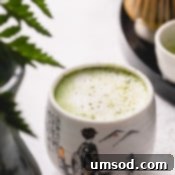
Did you make this?
Leave a rating and your feedback. Thank you!
This recipe was originally published on March 2nd, 2021, and has been updated and expanded for clarity and comprehensiveness.
